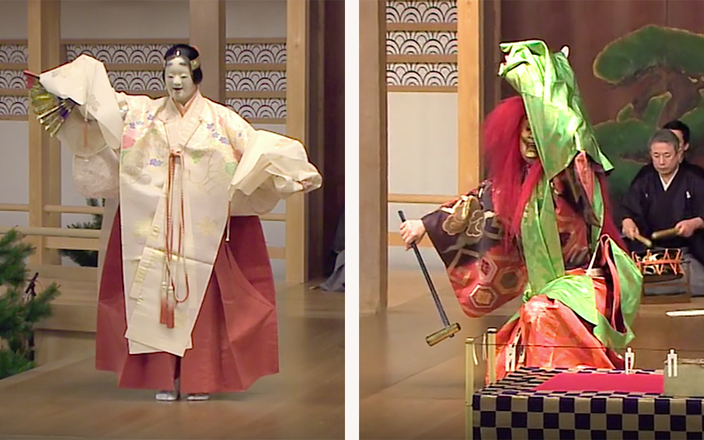Costumes
By Monica Bethe
Introduction
Noh costumes define a characterʼs gender, profession, and rank. Their layered elements are prescribed by tradition and can be found noted at the beginning of the utaibon (libretto). While the types of garments for a given play are regulated, their colors, patterns, and in some cases mimetic techniques serve as a tool for the actorʼs expression. In choosing the costume for a character the actor considers the image to be portrayed, the overall atmophere of the performance, and the balance of colors, patterns, and motif sizes as they play off the costumes of other characters. The performer usually has a stock of costumes from which to choose. Heads of schools and other actor families that own theaters as well as some individual actors have costumes collected over a long time span.
Noh costumes can be divided into four basic categories: (1) kosode “small-sleeved”, T-shaped, straight-lined, full-length garments similar to a modern kimono, with wrist-length sleeves that have their cuff edge sewn up half way to form a pocket. (2) ōsode or hirosode “broad-sleeved” outer garments. The various styles of ōsode outer garments all have extra wide sleeves, often double the weaving width, that are open at the cuff. These are worn over a kosode and are generally three-quarter length. (3) hakama, variously translated as trousers, pleated pants, or divided skirts depending on how voluminous they are. (4) accessories, including hairbands (kazura-obi), waist sashes (koshi-obi), head covers like crowns, hats, and helmets, and hand-held objects such as fans, prayer beads, weapons, sticks, and ritual objects.
[Note: the garments are listed by their Japanese names followed by an English description in parenthesis and then a semicolon. After the semicolon comes a description of the specific garment used for this production.]
Hashitomi
The shite in the first act: a Village Woman.
The stipulated costume for this role is the standard for young women appearing in the first act of a nō, certain details, however, hint at a high status.
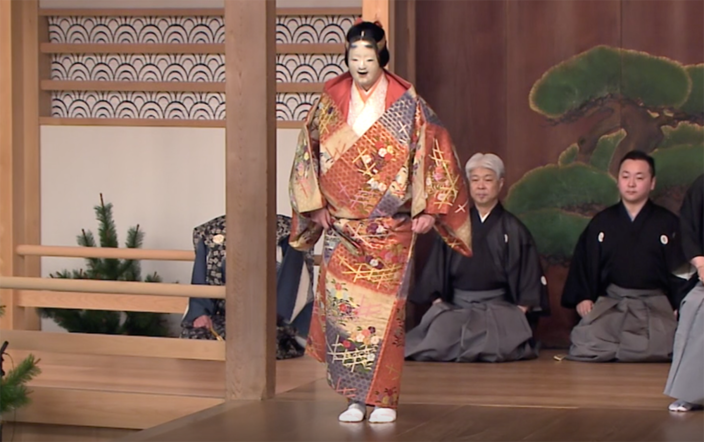
Mask: Young woman (Kongō school uses
Ko-omote)
Kazura: (woman’s wig, long black hair with center part and bound at the
nape of the neck).
Kazura-obi: (hairband); red ribbon with sections having embroidery on a gold
background.
Eri: (white and red collars); indicating high rank Surihaku,
(under kosode with gold-leaf stenciled design); white with flower
scroll design.
Karaori, (kosode with multi-colored woven patterning) iroiri, including red
indicating youth; the design here is pinks along fences over a
basket-weave motif on alternating blocks of blue, white, and red.
Kazura ōgi: (woman’s spread-tip fan).
The shite in the second act: Yūgao’s ghost.
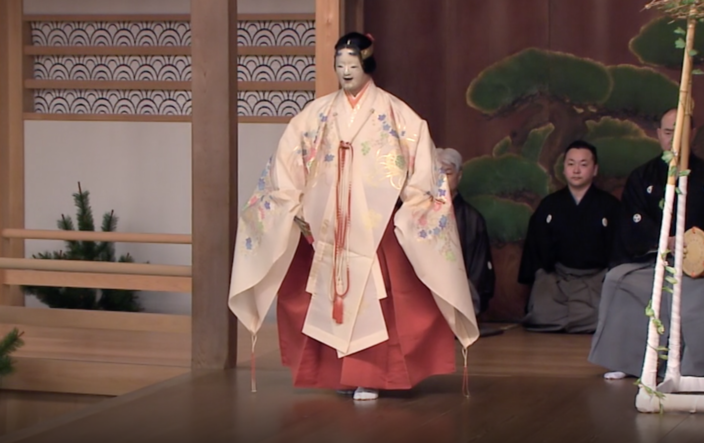
Mask, wig, hairband, collars, surihaku, and fan are the same as for
act one. The costume change consists of stripping the outer karaori,
and then putting on the following:
Ōkuchi, (divided skirts); red is typical for court ladies.
Koshi-obi, (waist sash); red with embroidery on a solid gold ground, not
visible under the chōken.
Chōken, (broad-sleeved gossamer over garment); woven design of flower carts
and mulberry leaves rendered in gold and colored threads.
The Waki: Monk.
The nameless travelling monk wears a simple costume in plain, sober colors.
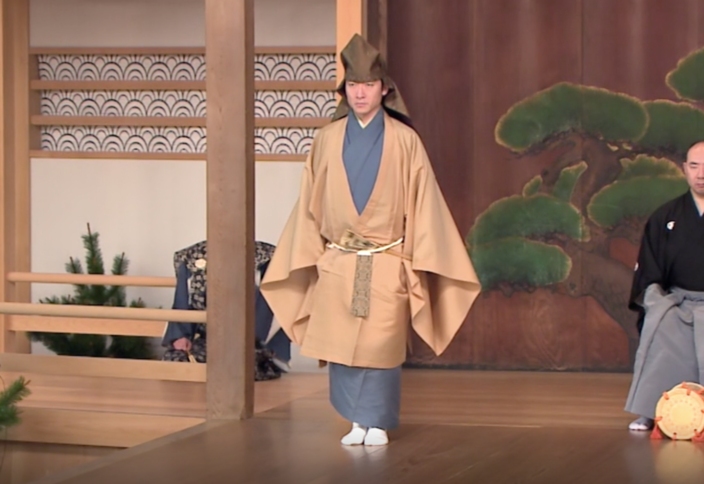
Sumi bōshi: (folded rectangular cloth hat); dark brown
Eri, (collar)
Noshime, (plain weave kosode worn by men); monochrome dark blue.
Mizugoromo, (broad-sleeveed travel coat); light brown, bound at the waist.
Koshi-obi, (waist sash); embroidered or woven rectangular panels decorate the
two ends and center back.
Juzu, (prayer beads); held in the right
hand.
Sumie-ōgi, (fan with ink painting); tucked into the waist band.
Kyōgen.
The kyōgen actor is a villager who fills in the story for the waki. The costume is standard for this role.
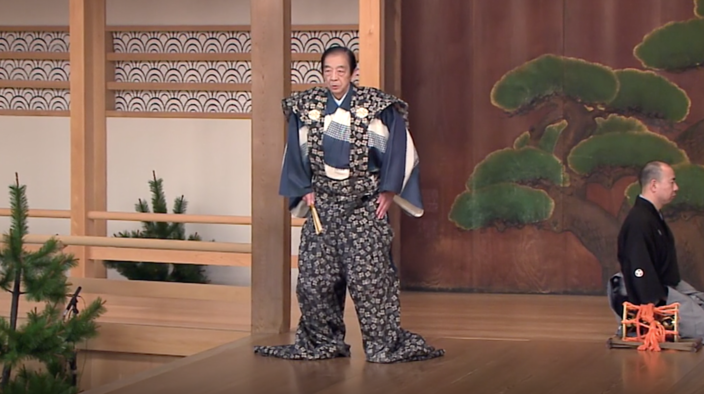
Kamishimo: (sleeveless matched suit); made of ramie or hemp and decorated with
a paste-resist stenciled white pattern on an indigo ground.
Nagabakama: (long trailing pleated trousers worn indoors, as one walks on the
bottom portion and the ends trail to the back); the danelion crests on
the chest and center back are standard for kyōgen costumes.
Ankle-length hakama are an alternative.
Noshime: (plain weave silk men’s kosode); the warp threads are
pre-dyed before weaving so that when the wefts are woven in they
produce horizontal bands of blue, white, and blue-and-white checks.
Kokaji
The shite in act one: a Youth
The youth here is in fact a manifestation in human form of the Fox deity. The red in his undergarment indicates his young age, and the garment itself is the soft embroidered nuihaku associated with women’s wear, but also worn by children until coming of age.
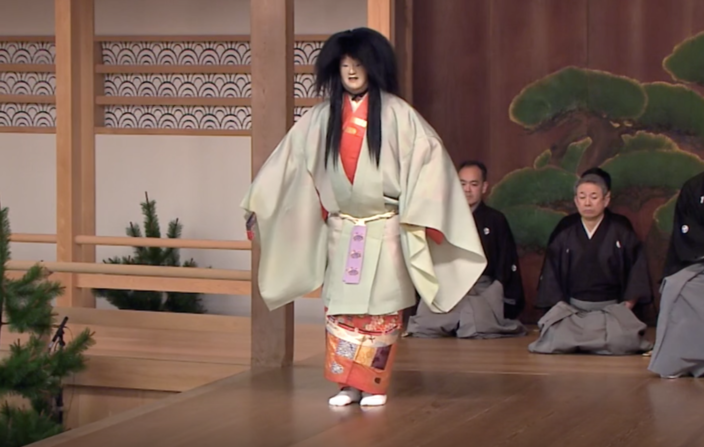
Mask:
Dōji or Jidō
Kurogashira: (black wig), long, shaggy, loose hair.
Hachimaki:(headband); kuroji kindon, gold brocaded on black satin. (not seen
under the wig)
Eri: (collar); white and red, or white and pale blue.
Nuihaku: (gold-stenciled and embroidered satin kosode), with red; design of
gold mist, curtain of many cloths, musical instruments.
Mizugoromo: (broad-sleeve travelling coat); plain weave, monochrome pale
blue.
Koshi-obi: (waist sash); embroidered with three paulownia crests.
Warabe-ōgi, child’s fan.
The shite in act two: Inari Myōjin, the Fox Deity.
The figure of a fox on the crown indicates the identity of the deity. His shaggy, bushy, long hair and the bulging eyes of his tobide mask express supernatural energy. He shite wears his happi jacket with the right sleeve slipped off and rolled up in the back so as to free his right arm when he hammer.
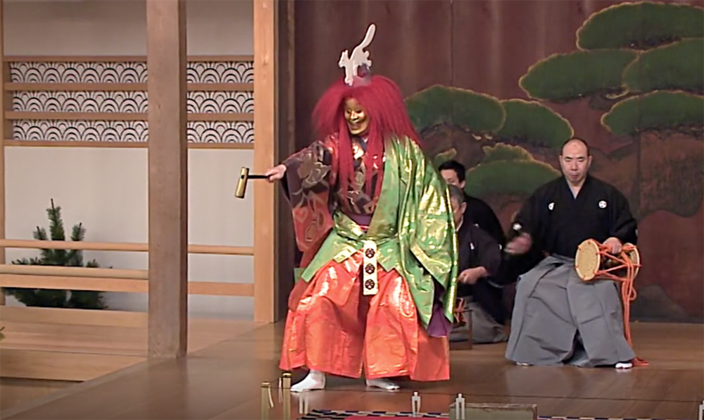
Mask: Kotobide or
Ōtobide
(Kongō school alternative, also variant performance standard)
Akagashira, (red shaggy wig), long bushy hair. Variant performances use a white
wig, (shirogashira).
Hachimaki : (headband); akaji
kindon, gold brocading on red satin.
Kitsune kanmuri: (fox crown); round base with a fox figure at the top.
Eri : (collar); navy or blue.
Atsuita: (brocaded kosode), dangawari aka-iri, alternate blocks of
red and black; design of flower-filled hexagons and clouds over a
lightning (inazuma) pattern.
Hangiri: (patterned divided skirts); gold
design of undulating vertical lines (tatewaku) filled with large peony
flowers on a red ground.
Awase happi : (lined broad-sleeved jacket);
woven design of large peony scrolls on a green ground.
Koshi-obi: (waist sash); embroidered with three temple-gong crests.
Tsuchi: (smith’s hammer)
The waki in act one: The swordsmith Sanjō Munechika
In the first act the waki is dressed in “street clothes” The hemp jacket is reminiscent of samurai garb, as is the style of folding the lacquer hat.
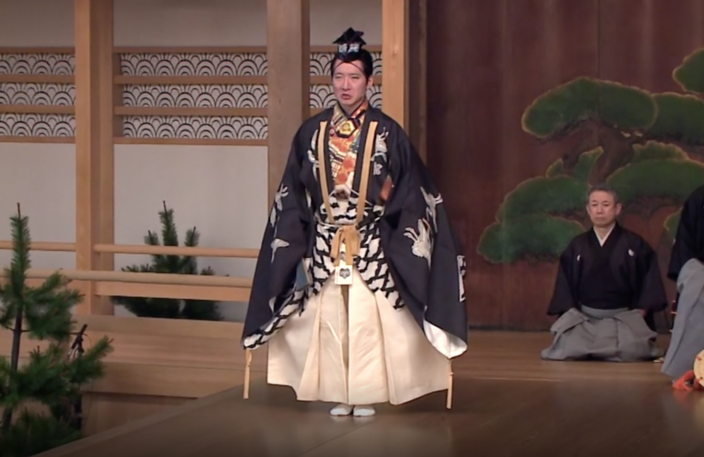
Samurai-eboshi: (also ori-eboshi), black lacquered hat that has been
folded down with a small triangle at the front.
Eri: (collar); blue.
Atsuita : (brocaded kosode); with
alternating blocks of large checks and of concentric flower-filled
hexagons on a red ground.
Ōkuchi : (divided skirts); white.
Kake-hitatare : (broad-sleeved jacket of a
matched hemp hitatare suit); paste-resist design of cranes and broken
ice in a “pine-bark” area division.
Koshi-obi :(waist sash); embroidered with
three crests.
Kokatana: (small sword)
Otoko-ōgi, man’s fan
The waki in act two: The swordsmith Sanjō Munechika
The waki changes his jacket and hat for the second act. This gives him a more formal attire, more suitable for the encounter with the deity, though hardly suitable for smithing. When actually at work, he slips the right sleeve off so the right arm is unhampered by the broad sleeves when hammering.
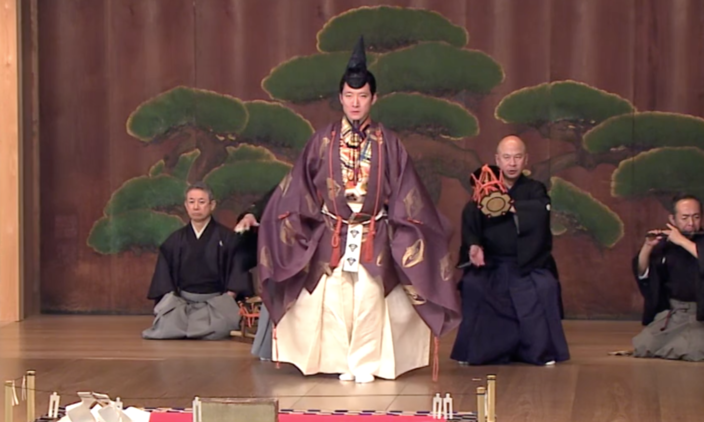
The Eri (collar), Atsuita (brocaded
kosode),Ōkuchi: (divided skirts),
Kokatana (small sword), and Otoko-ōgi, man’s fan are
all the same as in Act I.
Kazaori-eboshi, (black lacquered hat that has been folded to the side and tied with
cords).
Chōken, (broad-sleeved gossamer cloak); purple gauze weave with gold design
of facing cranes. (alternative: kamishimo matched suit)
Koshi-obi :(waist sash); embroidered with
three crests.
Wakizure: retainer of the minister Ichijō-in, Tachibana no Michinari
The wakizure wears a courtier’s costume, indicated by his round-collared kariginu jacket and his tall courtier’s cap.
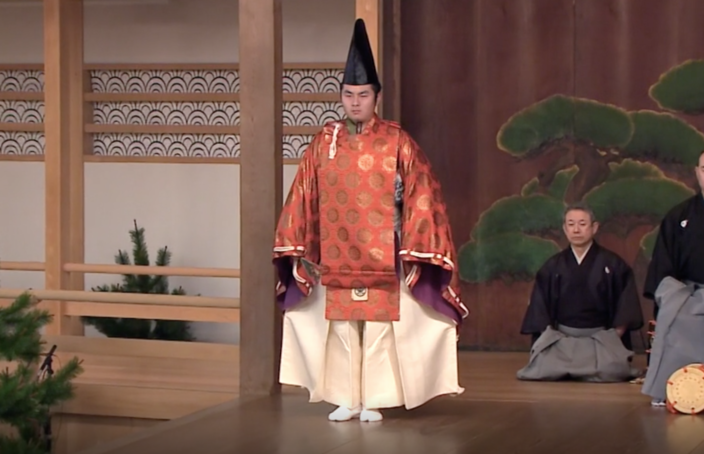
Eboshi : (lacquered tall hat, Kanze gold,
Kongō black); shown here is a Tate-eboshi, a black lacquered
tall courtier’s hat.
Eri : (collar); light blue or navy.
Atsuita: (brocaded kosode); not visible.
Ōkuchi: (divided skirts); white.
Awase kariginu : (lined broad-sleeve
courtier’s jacket with round collar and cords at the cuffs); design of
gold chrysanthemums over a wave pattern. (seigaiha)
Koshi-obi :(waist sash); embroidered with
three crests.
Otoko-ōgi, man’s fan.
Kyōgen actor: Subsidiary Shrine Diety
Small shrines within a shrine complex, known as massha, each have their own deity. In Noh the massha deities, performed by the kyōgen actors, serve as messangers announcing the advent of the main deity and often perform a short dance.
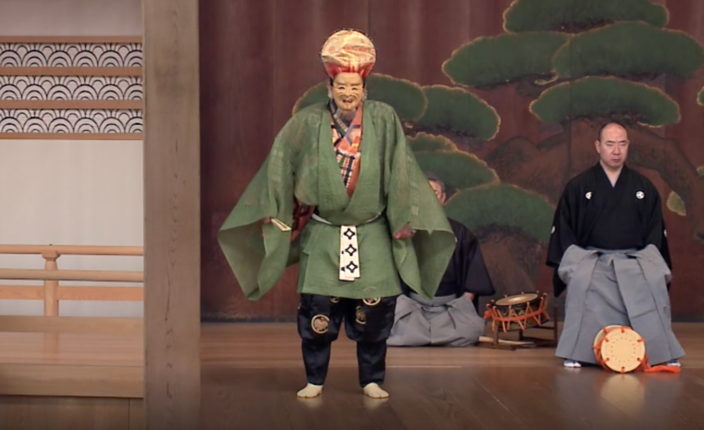
Mask: Noborihige
Massha zukin: (susidiary deity’s hat), a cloth hat folded to form a round
crown-like top.
Atsuita : (brocaded kosode);
alternating blocks of large checks and hexagons on a red ground.
Kukuri-bakama: (black pleated trousers with round crests bound at the calves).
Mizugoromo: (broad-sleeved coat); monochrome green.
Kyōgen ōgi: (kyōgen fan).
Musicians, Chorus, and Stage Attendants
The non-actor performers in nō are dressed in what corresponds to every-day formal garb.
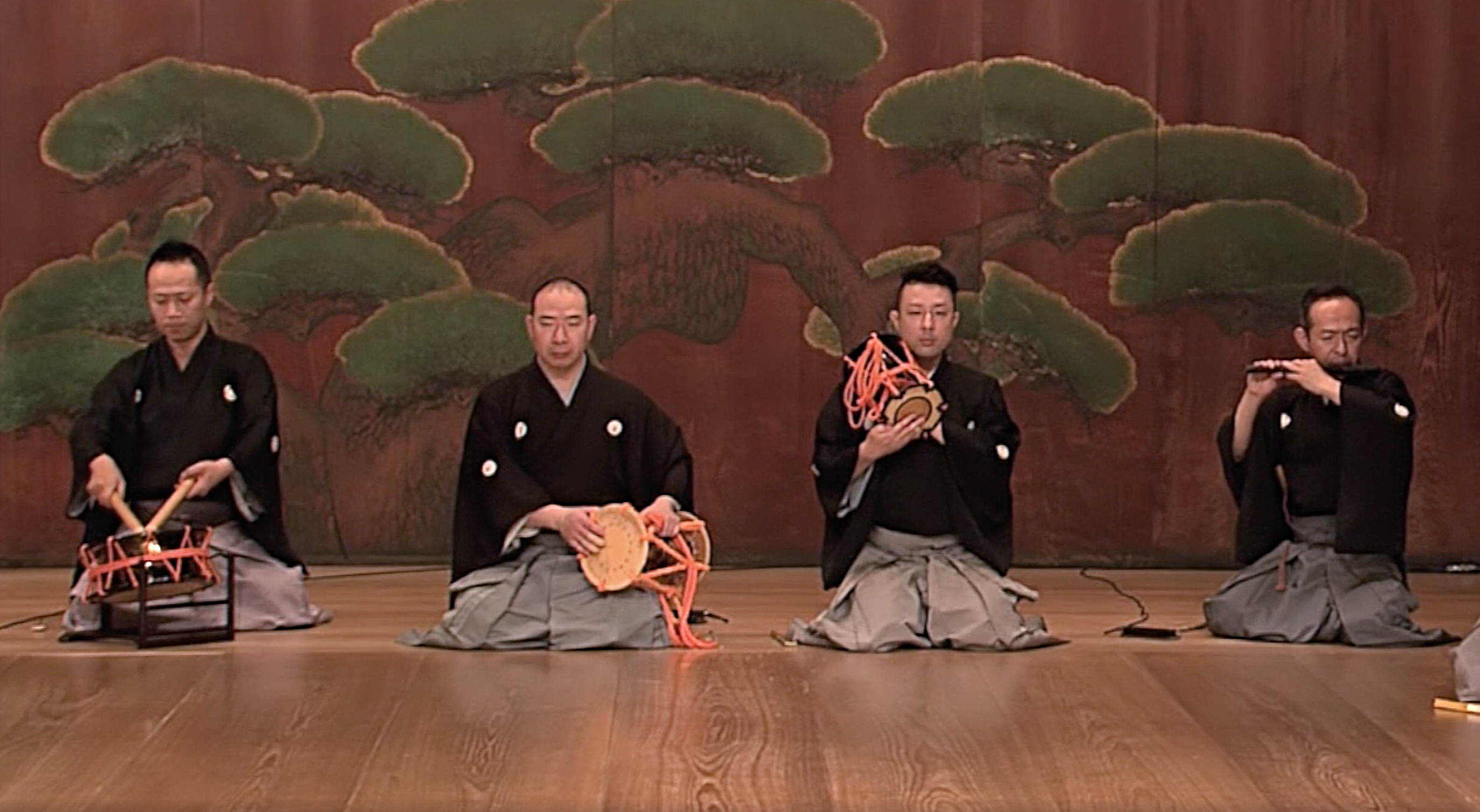
Monzuki: (silk kimono with family crests on the back at the center back and
sleeves and on the front at the chest); black is standard, though
other dark colors are acceptable on special occassions.
Hakama: (pleated trousers); for regular performances the musicians, chorus
members and stage atendants wear ankle-length, for very formal
performances, they wear nagabakama with trailing legs.
Comments:
Some of the costumes seen in Hashitomi and Kokaji are used for several roles, but draped differently. For instance, the chōken falls freely when draped on a woman who dances (Hashitomi act II). The cords are tied in a large bow knot over the chest. On the other hand, the chōken is belted when draped on a man, as for the costume of the waki in the second act (Kokaji act II). The cords run vertically and are securely knotted to the waist sash.
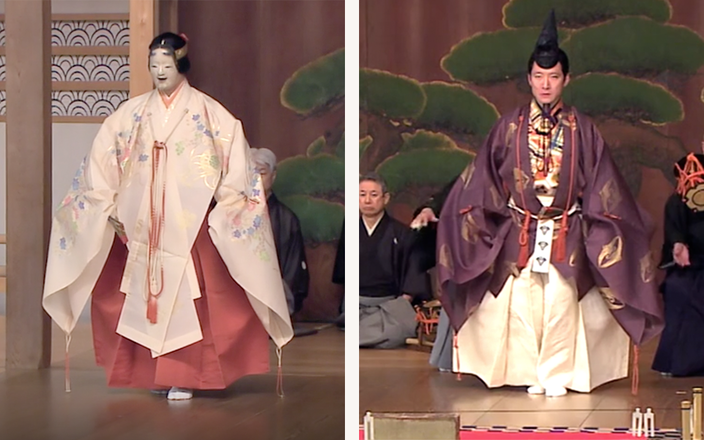
The mizugoromo is worn over a kosode for the waki monk in Hashitomi and by the shite in act I of Kokaji, though the type of kosode differs, as do the hair and hat, creating different impressions overall. For the kyōgen in Kokaji, however, the mizugoromo is draped over the pantaloon-like kukuri-bakama.
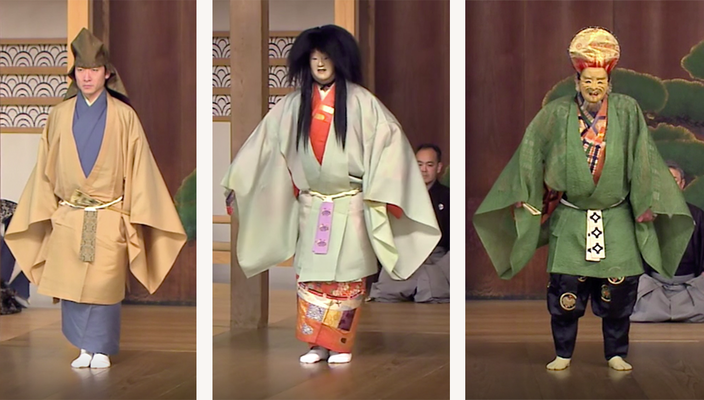
Brocaded kosode come in two forms: karaori and atsuita. While the karaori can be worn either as an outer (i.e. the shite in act I of Hashitomi) or an inner garment under a broad-sleeved garment, the atsuita is generally an undergarment worn by male characters under various types of broad-sleeved over garments. When one of the sleeves of the over garment is slipped off, the atsuita pattern is exposed more fully. The waki in Kokaji act II removes the right sleeve of the chōken in preparation for working on the sword.
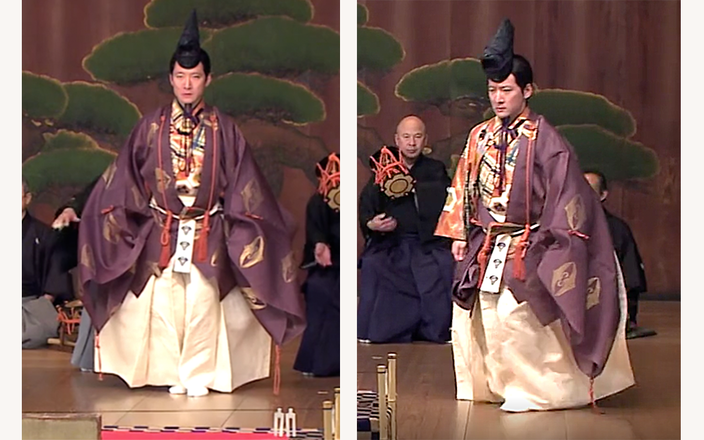
The shite, likewise, has prepared for work by slipping off the right sleeve of his happi ourter garment.

The broad sleeves of the ōsode outer garments provide for dynamic stage effect. During the jō-no-mai dance (Hashitomi act II), the sleeves of the chōken are flipped over the arms to intensify given moments right arm left arm. In Kokaji act II, the Fox deity twirls his sleeve raising the arm to half veil the face.
